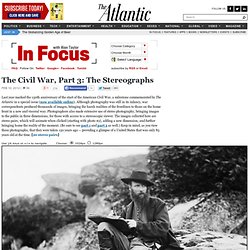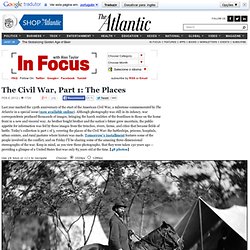

Under His Hat: In the Classroom. Civil War Battles & Civil War Casualties Interactive Map. Civil War: A Brief Overview by Sarah Olson on Prezi. The Civil War, Part 3: The Stereographs - In Focus. Last year marked the 150th anniversary of the start of the American Civil War, a milestone commemorated by The Atlantic in a special issue (now available online).

Although photography was still in its infancy, war correspondents produced thousands of images, bringing the harsh realities of the frontlines to those on the home front in a new and visceral way. Photographers also made extensive use of stereo photography, bringing images to the public in three dimensions, for those with access to a stereoscopic viewer. The images collected here are stereo pairs, which will animate when clicked (starting with photo #2), adding a new dimension, and further bringing home the reality of the moment. (Be sure to see part 1 and part 2 as well.) Keep in mind, as you view these photographs, that they were taken 150 years ago -- providing a glimpse of a United States that was only 85 years old at the time. [20 stereo pairs] Use j/k keys or ←/→ to navigate Choose: Photographer Timothy H. The Civil War, Part 2: The People - In Focus. Last year marked the 150th anniversary of the start of the American Civil War, a milestone commemorated by The Atlantic in a special issue (now available online).

Although photography was still in its infancy, war correspondents produced thousands of images, bringing the harsh realities of the frontlines to those on the home front in a new and visceral way. As brother fought brother and the nation's future grew uncertain, the public appetite for information was fed by these images. Today's collection is part 2 of 3, covering the people of the Civil War: the generals, slaves, civilians, politicians, and soldiers that lived through those turbulent years. Tomorrow, in part three I'll be sharing some of the amazing three-dimensional stereographs of the war. (Be sure to see part 1 as well.) Use j/k keys or ←/→ to navigate Choose: Abraham Lincoln, the 16th President of the United States, in a head-and-shoulders portrait taken by photographer Alexander Gardner on February 5, 1865.
Francis C. The Civil War, Part 1: The Places - In Focus. Last year marked the 150th anniversary of the start of the American Civil War, a milestone commemorated by The Atlantic in a special issue (now available online).

Although photography was still in its infancy, war correspondents produced thousands of images, bringing the harsh realities of the frontlines to those on the home front in a new and visceral way. As brother fought brother and the nation's future grew uncertain, the public appetite for information was fed by these images from the trenches, rivers, farms, and cities that became fields of battle. Today's collection is part 1 of 3, covering the places of the Civil War: the battleships, prisons, hospitals, urban centers, and rural pastures where history was made. Tomorrow's installment features some of the people involved in the conflict, and on Friday I'll be sharing some of the amazing three-dimensional stereographs of the war. Use j/k keys or ←/→ to navigate Choose: A March, 1863 photo of the USS Essex. Almost 150 years after it sank, Monitor still captivates.
Below deck, the rising water sloshed almost waist deep.

Several members of the crew were paralyzed by seasickness or fear. And a master’s mate gave a watch away, sensing his doom. It was a “panorama of horror,” a survivor recalled, one that “would have appalled the stoutest heart.” And as the USS Monitor was pounded by the ocean, the skipper signaled to his escort ship to send the lifeboats: He was sinking. It was Dec. 31, 1862, and as the moon set over the North Carolina coast, the strange iron-covered vessel — the ship that had so recently saved the Union — vanished, leaving behind only an eddy on the surface. The engine room clock was later found stopped around 1 a.m., marking the moment of one of the great naval tragedies of the Civil War. A battle for the ages Ten months earlier — 150 years ago this month — the Monitor had become the nation’s salvation and had altered the course of the war. Cotton-gin-patent. Slave Population of U.S. States and Territories 1790, 1820, 186.
Mission 2: "Flight To Freedom" <object classid="clsid:D27CDB6E-AE6D-11cf-96B8-444553540000" width="800" height="600" id="mission_2"><param name="movie" value="//cdn.mission-us.org/flash/streaming_mission02/mission02.swf" /><param name="quality" value="high" /><param name="bgcolor" value="#000000" /><param name="allowScriptAccess" value="sameDomain" /><param name="allowFullScreen" value="true" /><param name="wmode" value="transparent" /><param name="flashvars" value="base_path=//cdn.mission-us.org/flash/streaming_mission02/" /><!

--[if ! IE]>--><object type="application/x-shockwave-flash" data="//cdn.mission-us.org/flash/streaming_mission02/mission02.swf" width="800" height="600"><param name="quality" value="high" /><param name="bgcolor" value="#000000" /><param name="allowScriptAccess" value="sameDomain" /><param name="allowFullScreen" value="true" /><! --<! [endif]--><! --[if gte IE 6]>--><p> Whoops! Chromebook and Chrome users: If you see a blank screen above, your browser may be blocking Flash content.
History & Social Studies. The Civil War in Four Minutes. The Best Civil War Photos - Photo Gallery.